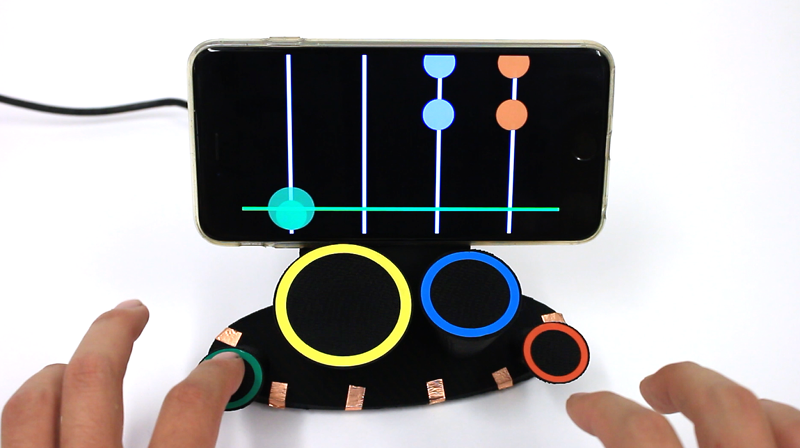Touch screens are great, but big touchscreens are expensive and irregular touchscreens are not easy to make at all. Electrik is a method developed by several researchers at Carnegie Mellon University that makes almost any solid object into a touch surface using tomography. The catch is that a conductive coating — in the form of conductive sheets, 3D plastic, or paint — is necessary. You can see a demonstration and many unique applications in the video below. They’ve even made a touch-sensitive brain out of Jell-O and a touchable snowman out of Play-Doh.
The concept is simple. Multiple electrodes surround the surface. The system injects a current using a pair of electrodes and then senses the output at the other terminals. A finger touch will change the output of several of the electrodes. Upon detection, the system will change the injection electrodes and repeat the sensing. By using multiple electrode pairs and tomography techniques, the system can determine the location of touch and even do rough motion tracking like a low-resolution touch pad mouse.
In addition to the video, there is a lecture video and a paper available. There are enough details that you should be able to experiment with this technique yourself. The prototype used a Teensy board with Bluetooth to allow objects to run wirelessly. The excitation signal was a 200 kHz sine wave driving a voltage-controlled current source, providing a constant AC current. Multiplexers allow the use of many electrodes, which is key to being able to get a reasonable resolution. At least, that’s true to a point. The researchers found that after a certain number of electrode pairs, the accuracy actually got worse for a particular size object.
Some of the more interesting use cases included a touch sensitive wall, a computer desk with hot spots, and a touch-enabled steering wheel. The system will operate through ordinary paint or even stickers.
We’ve seen other schemes to make large touch surfaces. We’ve also seen cement made touch sensitive. We hope to see more projects that use the Electrick technique soon.
















Part of the reason touch works as well as it does is the information underneath, be it dynamic, or static like a blank white wall.
Does this detect the change in resistance your finger bridging the conductive material induces, or does this need a “hidden” wire on your body to complete a circuit like that makemakey fad?
Doesnt look like it needs any hidden wires. Sounds like they use quadrants by switching different electrodes and measuring the current. Your finger seems to change the resistance and therefore current measured at electrodes. I guess mapping it is where the training comes in.
Correction: should have read the paper first, sounds like a finger will change the current by leaking it to earth, not changing the resistance.
The circuit looks like this,
http://oi64.tinypic.com/eip6xc.jpg
The tomography works like this,
http://i68.tinypic.com/5feule.jpg
This should be worth doing with now, just begs an arduino!
There have been several attempts over the years with discrete analog electronics giving x/y position of your touch in just this way, but they suffered a need of constant manual recalibration due to wear of the substrate, fingerprints, and even humidity changes. Simple long strips worked reasonably as sliders though never caught on much. Now you can throw an arduino at it, and have it recalibrate in software as often as you want. Touch in the corner to start a recal, then touch 4 or more known positions in sequence, done. Reliabiity will be up there.
Don’t let the mention of tomography calcs disturb you. What’s needed for a two dimensional array being touched at one location at a time won’t be thick math. You can easily imagine what it would be for a one dimension single slider strip… it’s just two of those. Your processor also won’t know or care if the surface is flat or curved, has holes cut in it, etc.
Detecting touch by it’s leak through air to earth is high impedance and subject to noise, but works. If it’s a handheld device with a contact plate you’re touching as ground then overall performance and accuracy will improve a great deal, but for safety put 10k to 20k in series with that contact plate to system ground for safety.
I can’t help myself, but the disadvantages immediately spring into my mind:
Really low resolution, susceptibility to all sorts of EM disturbances, not usable with gloves, dry hands, and while standing on a non conducting surface, problems with rain and high air humidity, extreme drift, etc.
My washing machine has touch buttons, and they regularly drive me crazy, because I often wear well insulated shoes.
I also have several development kits here, that have touch elements, and none of them are really convincing.
That’s understandable, it’s not perfect, but I can’t think of a better system for organically shaped surfaces.
Where to buy/what to buy in respect to the application (conductive) liquid/spray surfaces etc. Any suggestions?
if you visit any computer shop and ask/beg for the bags that motherboards come in, that uses the conductive film polymer. you can probably make your own surface with some paint primer and spinkle on black toner (be wary of toner though, it’s bad for you, bad for everyone. Do it outside, in no wind, with damp surfaces, in a box, with decent ppe.